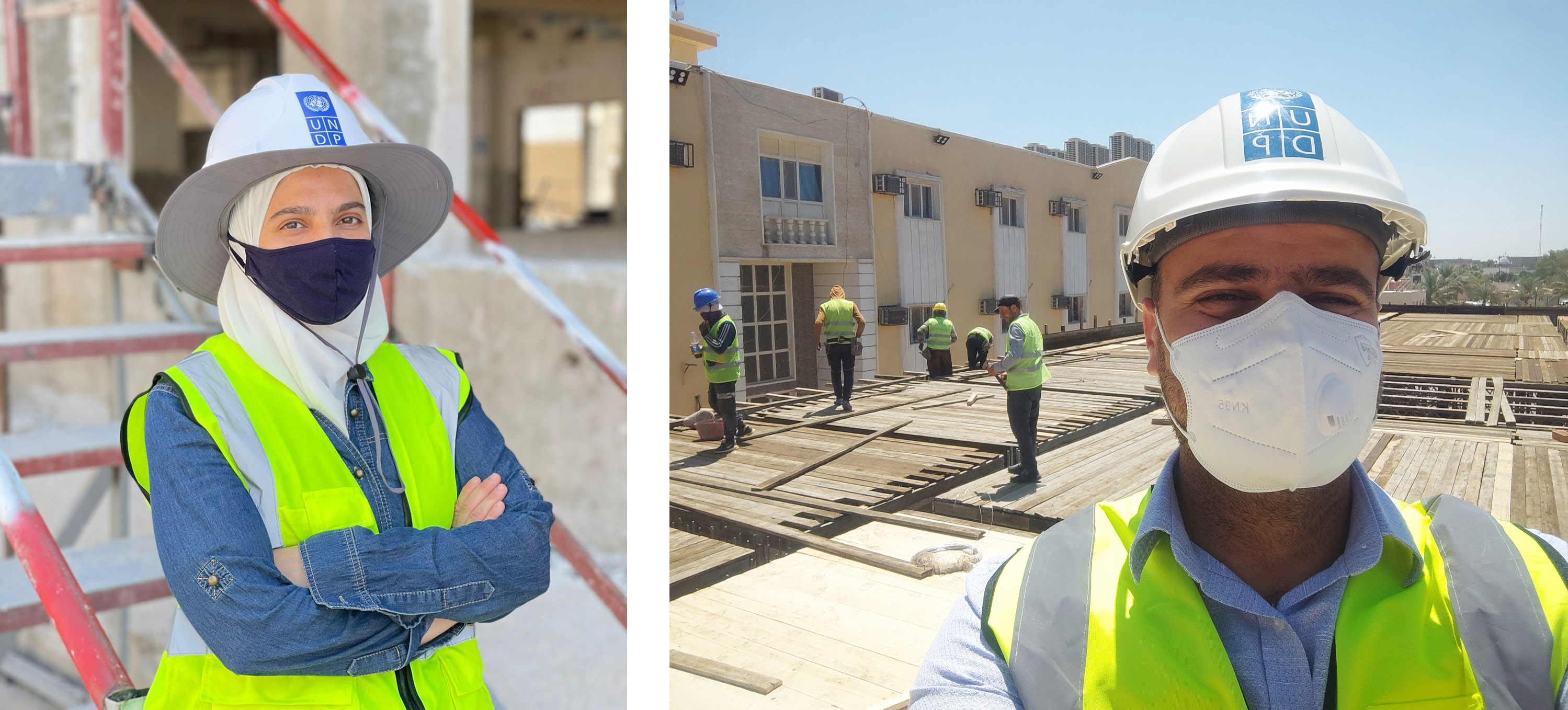
Electrical engineer Lama Assasa (left) stands outside the Nursing and Pharmacy College of Ninewa University in Mosul and engineer Ali Noori (right) at a reconstruction site in Ramadi. Photo: UNDP Iraq
Five years since the liberation from ISIL, UNDP continues to work with the Government of Iraq to stabilize and rebuild critical infrastructure and services lost during the conflict. Implemented through the Funding Facility for Stabilization (FFS), over 95 percent of the work is contracted through the local private sector, which reduces costs, bolsters local economies and provides emergency incomes.
But what does it mean for engineers from Iraq to rebuild their country post-ISIL? How do these stabilization efforts create a safe and dignified environment for Iraqis to return?
Behind the programme lies a strong team of over 200 skilled engineers across central and northern Iraq. With boots on the ground, they are best placed to answer these questions. Read on.
Lama: Hello, I am Lama Assasa from the historic city of Damascus in Syria. I started working for UNDP Iraq in 2019 as an electrical engineer covering Mosul and its surrounding areas. What about you?
Ali: It is lovely to meet you, Lama. I am Ali Noori from Ramadi in Anbar. I have been working with the programme since 2017. I have always dreamt of becoming an engineer and making a change, however big or small. It is more relevant today, as my country recovers from years of conflict and fragility.
Lama: You reminded me of what got me started in the first place. I always wanted to build and develop my own country, so engineering was the place for me. I love that my job impacts people’s lives directly.
Ali: I could not agree more with you, Lama. Since I graduated in 2007, I have worked as an engineer with several organizations to rehabilitate damaged infrastructure across Iraq. Through the years, I have mastered the ability to ensure the quality of construction and make the right decisions to solve daily challenges. So, what are the challenges you face while on the job?
Lama: The main challenges I face are ensuring we meet the required specifications and tight deadlines to hand over the rehabilitated infrastructure to the local authorities. Honestly, this would not be possible without teamwork and setting clear timelines.
I must add. The most exciting part of my role is to monitor progress at the worksites and then see how a particular service restored directly impacts the community. What about you, Ali?
Ali: Due to ISIL, most of the infrastructure and services in Anbar were destroyed, along with the large-scale displacement of people. We had to be quick on our feet to develop and implement a plan to restore infrastructure across the health, water, sanitation, education, and electricity sector. Shortly after the launch of UNDP’s stabilization programme in Ramadi, I was one of the first engineers who returned to the city to supervise the projects.
After liberation from ISIL, I returned with my family to a partially damaged house. I witnessed the destruction firsthand and was determined to restore my city to its earlier glory.
The programme has left a positive impact on the lives of people in Anbar. People now trust that we will deliver when we commit to a particular project. Some residents are even encouraged to join us. At one of the schools we rehabilitated in Ramadi, the school’s staff volunteered to work with us to speed up the reconstruction so the children could go back to school. At another electricity site, residents who lived near the site provided food and water to the engineers. We even had cases of residents guarding and storing project material free of cost.
Lama: Initially, finding the right expertise to work on specialized projects was difficult because most engineers left due to ISIL. Our rehabilitation projects create employment opportunities and improve the quality of life, encouraging people to return home and rebuild their cities. I believe unlocking local capacity is key to building back Iraq sustainably.
Ali: This programme stands true testament to that. A local solution to local problems. I am happy to be here. I hope we continue to help Iraqis who have suffered from years of conflict recover as needs remain.
Lama: I agree. So much of the infrastructure remains damaged and people displaced. Although we have completed many infrastructure projects, hospitals, electricity substations, water treatment plants, shops, schools and homes are still damaged. We need to start shifting our focus to creating sustainable livelihoods and continuous access to essential services for returning families, preventing re-displacement.
The Funding Facility for Stabilization has completed 2,906 projects. It is currently implementing 278 projects across Anbar, Salah al Din, Diyala, Ninewa and Kirkuk, benefitting over 14.6 million people.

 Locations
Locations








